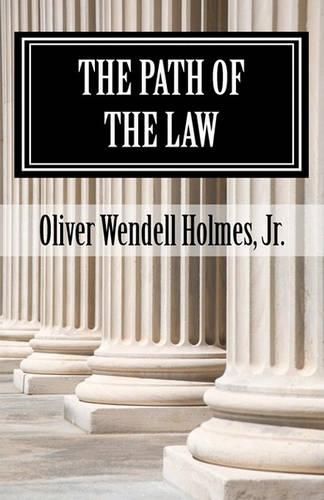Readings Newsletter
Become a Readings Member to make your shopping experience even easier.
Sign in or sign up for free!
You’re not far away from qualifying for FREE standard shipping within Australia
You’ve qualified for FREE standard shipping within Australia
The cart is loading…






Building on the pragmatic conception of law he introduced in his 1881 book ‘The Common Law, ’ Oliver Wendell Holmes, Jr. – by 1897 a jurist on Massachusetts’ highest court and soon to be an Associate Justice of the U.S. Supreme Court – explored the limits and sources of law, as well as the forces which determine its content and growth. This presentation is seen as laying down the gauntlet to legal scholars and judges in what would be known as the emerging legal realism movement. Later legal thinkers like Pound, Llewellyn and Douglas followed his lead, and that lead is seen most clearly in this essay. By the time of this pithy and accessible writing, Holmes had crystallized and clarified that conception of law which he had, in introducing his earlier book, described in the famous statement the life of the law is not logic: it is experience. Taking that observation to the next level, this essay made it clear that judges make law, not simply finding it in books – and they must draw on practical effects and ends in declaring legal rules, not simply reasoning from precedent. He does not hedge: it is a fallacy to think that the only force at work in the development of the law is logic. More controversially, this essay makes a powerful distinction between law and morality. Law is more about what judges do, and how people react to that, than some lofty sense of ethics, he suggests. But is his figure of the bad man a hero or a cautionary tale? A realistic way to look at law and social control…or a precursor to Hitler and Stalin?
$9.00 standard shipping within Australia
FREE standard shipping within Australia for orders over $100.00
Express & International shipping calculated at checkout
Building on the pragmatic conception of law he introduced in his 1881 book ‘The Common Law, ’ Oliver Wendell Holmes, Jr. – by 1897 a jurist on Massachusetts’ highest court and soon to be an Associate Justice of the U.S. Supreme Court – explored the limits and sources of law, as well as the forces which determine its content and growth. This presentation is seen as laying down the gauntlet to legal scholars and judges in what would be known as the emerging legal realism movement. Later legal thinkers like Pound, Llewellyn and Douglas followed his lead, and that lead is seen most clearly in this essay. By the time of this pithy and accessible writing, Holmes had crystallized and clarified that conception of law which he had, in introducing his earlier book, described in the famous statement the life of the law is not logic: it is experience. Taking that observation to the next level, this essay made it clear that judges make law, not simply finding it in books – and they must draw on practical effects and ends in declaring legal rules, not simply reasoning from precedent. He does not hedge: it is a fallacy to think that the only force at work in the development of the law is logic. More controversially, this essay makes a powerful distinction between law and morality. Law is more about what judges do, and how people react to that, than some lofty sense of ethics, he suggests. But is his figure of the bad man a hero or a cautionary tale? A realistic way to look at law and social control…or a precursor to Hitler and Stalin?